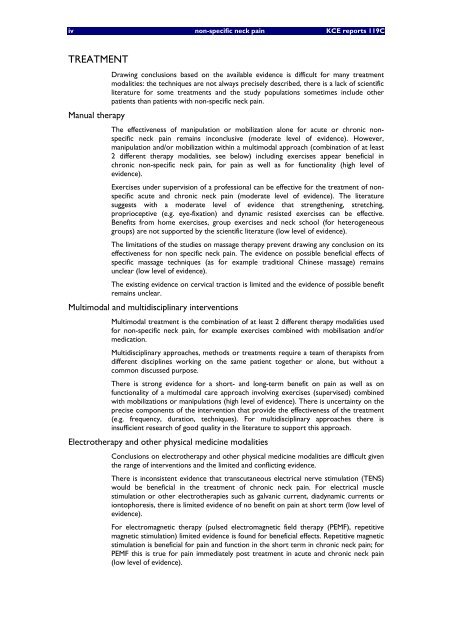Non-specific neck pain: diagnosis and treatment - KCE
Non-specific neck pain: diagnosis and treatment - KCE
Non-specific neck pain: diagnosis and treatment - KCE
You also want an ePaper? Increase the reach of your titles
YUMPU automatically turns print PDFs into web optimized ePapers that Google loves.
iv non-<strong>specific</strong> <strong>neck</strong> <strong>pain</strong> <strong>KCE</strong> reports 119C<br />
TREATMENT<br />
Drawing conclusions based on the available evidence is difficult for many <strong>treatment</strong><br />
modalities: the techniques are not always precisely described, there is a lack of scientific<br />
literature for some <strong>treatment</strong>s <strong>and</strong> the study populations sometimes include other<br />
patients than patients with non-<strong>specific</strong> <strong>neck</strong> <strong>pain</strong>.<br />
Manual therapy<br />
The effectiveness of manipulation or mobilization alone for acute or chronic non<strong>specific</strong><br />
<strong>neck</strong> <strong>pain</strong> remains inconclusive (moderate level of evidence). However,<br />
manipulation <strong>and</strong>/or mobilization within a multimodal approach (combination of at least<br />
2 different therapy modalities, see below) including exercises appear beneficial in<br />
chronic non-<strong>specific</strong> <strong>neck</strong> <strong>pain</strong>, for <strong>pain</strong> as well as for functionality (high level of<br />
evidence).<br />
Exercises under supervision of a professional can be effective for the <strong>treatment</strong> of non<strong>specific</strong><br />
acute <strong>and</strong> chronic <strong>neck</strong> <strong>pain</strong> (moderate level of evidence). The literature<br />
suggests with a moderate level of evidence that strengthening, stretching,<br />
proprioceptive (e.g. eye-fixation) <strong>and</strong> dynamic resisted exercises can be effective.<br />
Benefits from home exercises, group exercises <strong>and</strong> <strong>neck</strong> school (for heterogeneous<br />
groups) are not supported by the scientific literature (low level of evidence).<br />
The limitations of the studies on massage therapy prevent drawing any conclusion on its<br />
effectiveness for non <strong>specific</strong> <strong>neck</strong> <strong>pain</strong>. The evidence on possible beneficial effects of<br />
<strong>specific</strong> massage techniques (as for example traditional Chinese massage) remains<br />
unclear (low level of evidence).<br />
The existing evidence on cervical traction is limited <strong>and</strong> the evidence of possible benefit<br />
remains unclear.<br />
Multimodal <strong>and</strong> multidisciplinary interventions<br />
Multimodal <strong>treatment</strong> is the combination of at least 2 different therapy modalities used<br />
for non-<strong>specific</strong> <strong>neck</strong> <strong>pain</strong>, for example exercises combined with mobilisation <strong>and</strong>/or<br />
medication.<br />
Multidisciplinary approaches, methods or <strong>treatment</strong>s require a team of therapists from<br />
different disciplines working on the same patient together or alone, but without a<br />
common discussed purpose.<br />
There is strong evidence for a short- <strong>and</strong> long-term benefit on <strong>pain</strong> as well as on<br />
functionality of a multimodal care approach involving exercises (supervised) combined<br />
with mobilizations or manipulations (high level of evidence). There is uncertainty on the<br />
precise components of the intervention that provide the effectiveness of the <strong>treatment</strong><br />
(e.g. frequency, duration, techniques). For multidisciplinary approaches there is<br />
insufficient research of good quality in the literature to support this approach.<br />
Electrotherapy <strong>and</strong> other physical medicine modalities<br />
Conclusions on electrotherapy <strong>and</strong> other physical medicine modalities are difficult given<br />
the range of interventions <strong>and</strong> the limited <strong>and</strong> conflicting evidence.<br />
There is inconsistent evidence that transcutaneous electrical nerve stimulation (TENS)<br />
would be beneficial in the <strong>treatment</strong> of chronic <strong>neck</strong> <strong>pain</strong>. For electrical muscle<br />
stimulation or other electrotherapies such as galvanic current, diadynamic currents or<br />
iontophoresis, there is limited evidence of no benefit on <strong>pain</strong> at short term (low level of<br />
evidence).<br />
For electromagnetic therapy (pulsed electromagnetic field therapy (PEMF), repetitive<br />
magnetic stimulation) limited evidence is found for beneficial effects. Repetitive magnetic<br />
stimulation is beneficial for <strong>pain</strong> <strong>and</strong> function in the short term in chronic <strong>neck</strong> <strong>pain</strong>; for<br />
PEMF this is true for <strong>pain</strong> immediately post <strong>treatment</strong> in acute <strong>and</strong> chronic <strong>neck</strong> <strong>pain</strong><br />
(low level of evidence).

















